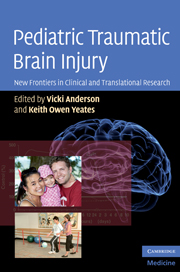Book contents
- Frontmatter
- Contents
- List of contributors
- Acknowledgments
- Introduction: Pediatric traumatic brain injury: New frontiers in clinical and translational research
- 1 Biomechanics of pediatric TBI
- 2 Neurobiology of TBI sustained during development
- 3 Using serum biomarkers to diagnose, assess, treat, and predict outcome after pediatric TBI
- 4 Clinical trials for pediatric TBI
- 5 Advanced neuroimaging techniques in children with traumatic brain injury
- 6 Neurobehavioral outcomes of pediatric mild traumatic brain injury
- 7 Very long-term neuropsychological and behavioral consequences of mild and complicated mild TBI: increased impact of pediatric versus adult TBI
- 8 Neurobehavioral outcomes of pediatric traumatic brain injury
- 9 Neuropsychological rehabilitation in children with traumatic brain injuries
- 10 Psychosocial interventions
- 11 Pediatric TBI: challenges for treatment and rehabilitation
- 12 Integrating multidisciplinary research for translation from the laboratory to the clinic
- Index
- Plate section
- References
1 - Biomechanics of pediatric TBI
Published online by Cambridge University Press: 14 May 2010
- Frontmatter
- Contents
- List of contributors
- Acknowledgments
- Introduction: Pediatric traumatic brain injury: New frontiers in clinical and translational research
- 1 Biomechanics of pediatric TBI
- 2 Neurobiology of TBI sustained during development
- 3 Using serum biomarkers to diagnose, assess, treat, and predict outcome after pediatric TBI
- 4 Clinical trials for pediatric TBI
- 5 Advanced neuroimaging techniques in children with traumatic brain injury
- 6 Neurobehavioral outcomes of pediatric mild traumatic brain injury
- 7 Very long-term neuropsychological and behavioral consequences of mild and complicated mild TBI: increased impact of pediatric versus adult TBI
- 8 Neurobehavioral outcomes of pediatric traumatic brain injury
- 9 Neuropsychological rehabilitation in children with traumatic brain injuries
- 10 Psychosocial interventions
- 11 Pediatric TBI: challenges for treatment and rehabilitation
- 12 Integrating multidisciplinary research for translation from the laboratory to the clinic
- Index
- Plate section
- References
Summary
Traumatic brain injury (TBI) is a leading cause of death and disability among children and young adults in the United States (NCIPC, 2000). Each year TBI results in approximately 3000 childhood deaths, 29,000 hospitalizations, and 400,000 emergency department visits. The predominant causes of TBI in young children are motor vehicle accidents, firearm incidents, falls, and child abuse.
Since the 1940s biomechanics has made a significant contribution to understanding the mechanisms and tolerances of adult traumatic brain injury and it continues to play a crucial role in forming guidelines for adult motor vehicle occupancy and sports safety (Goldsmith, 2001; Goldsmith & Monson, 2005). Biomechanical research specific to pediatric traumatic brain injury did not begin until the late 1970s and the paucity of pediatric biomechanical data at the time forced researchers to make assumptions regarding the relationship of infant material properties to adult material properties (Mohan et al., 1979). Since then, biomechanical researchers have measured many pediatric tissue properties directly. Biomechanical studies of the intact skull and brain and the properties of individual tissues have demonstrated that the pediatric brain and skull respond differently to loads than adult tissue, and previous linear extrapolation from adult data does not provide an accurate estimate of pediatric properties (Coats & Margulies, 2006; Prange & Margulies, 2002).
Despite the increased research in the field, not enough key pieces of information are in place to establish realistic injury tolerances for children.
- Type
- Chapter
- Information
- Pediatric Traumatic Brain InjuryNew Frontiers in Clinical and Translational Research, pp. 7 - 17Publisher: Cambridge University PressPrint publication year: 2010
References
- 3
- Cited by



